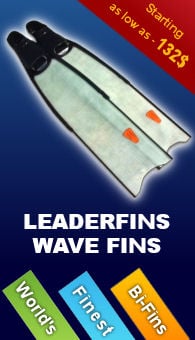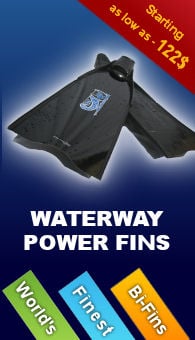Movement Techniques In WaterThe following article will examine the different methods of movement used by freedivers in water. It is important to remember that movement within water is not an exact science. Eventually, every freediver develops their own style and technique for underwater movement.In General
Whether you are using bi-fins or a freediving monofin, the motion of your legs should be wide and relatively slow in order to fully utilize the complete width and length
of the fin and enhance the efficiency of movement underwater. Avoid moving any body parts which are not related to the movement of the fins (hands, head etc.) in order to save oxygen and to keep a streamlined position. If you are using, for instance, an equalization technique that requires you to use your hand, place your hand on your nose at the beginning of the free dive and your elbow close to your body so it touches the ribcage. This will prevent you from moving your hand back and forth in order to equalize, placing your elbow close to your body will help you stay streamlined in the water. Avoid any sharp movements underwater, sharp movements might lead to a faster heart rate and blood circulation, causing the body to use oxygen inefficiently which leads to the premature ending of the free dive - it is important to be as relaxed as possible before and during the dive.
Duck dive
In order to efficiently penetrate the surface of the water, we must perform a duck dive - tilting our body to an angle of 90 degrees to the surface of the water. When we tilt our body that way, the surface area of our body becomes much smaller and it enables our body to be pushed inside the water by its own weight. Some people use a single stroke motion with their hands in order to fully push their body into the water in case the body is unable to completely slide into the water using its own weight.
Movement Underwater
There are two main methods of movement once underwater;
1) Using both legs - each leg moves in the opposite direction of the other to form an elliptic - round shape. Both legs must move symmetrically - they must be at the same distance from the center of the body at all times. This technique requires perfect coordination between both legs in order to perform an oxygen saving and muscle power efficient movement. When using this technique the freediver also tilts his body with each leg movement to the opposite direction of the leg that is currently "raised" (over the back).
2) Using the entire body as a whip while the fins or monofin is used to push the freediver through the water (dolphin style). In order to use this technique efficiently, the freediver must create a movement above his pelvis and use his body to transfer that movement all the way to the end of the fin, causing it to "whip" the water and push the freediver forward. The entire process of transferring the movement to the fin must be done without any unneeded contraction of any muscles, the freediver must keep his body completely loose and just let the motion pass on to the fin without interfering with it. It is important to bend your knees when using this technique in order to enable to motion to pass to the fin. Using this technique efficiently requires a lot of practice.

Wednesday, March 26, 2008
Movement Techniques
Subscribe to:
Post Comments (Atom)








No comments:
Post a Comment
Note: Only a member of this blog may post a comment.